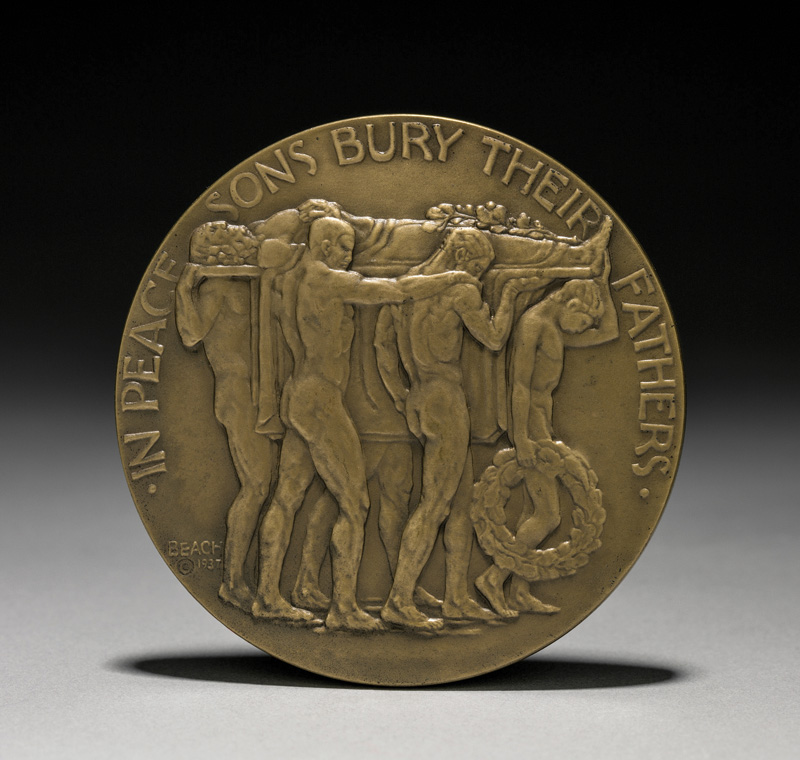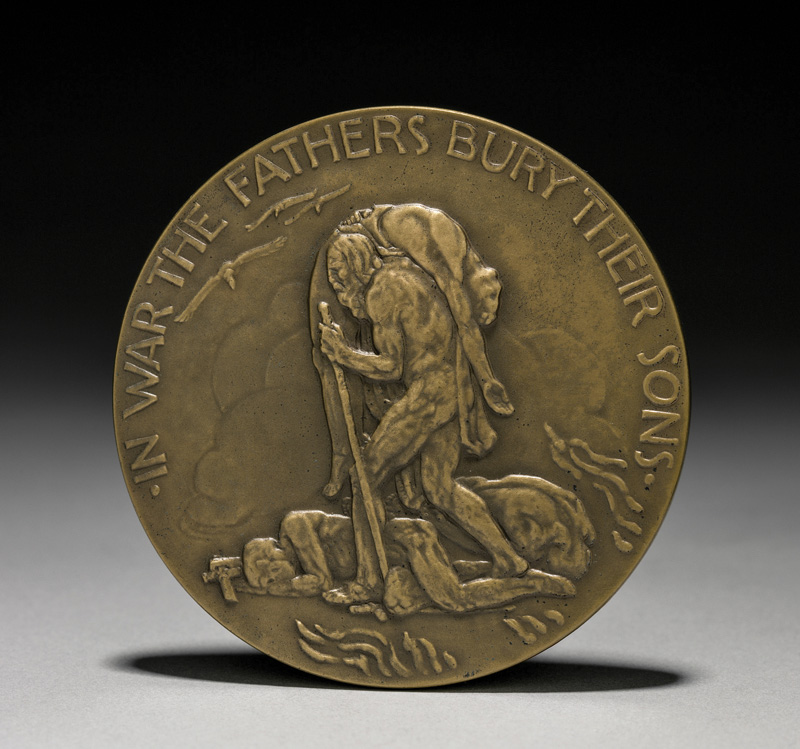
About a decade ago, when I worked at the Victoria and Albert Museum in London, a little joke was making the rounds. The V&A’s director at the time was the distinguished scholar Mark Jones. He had begun his career in the British Museum’s numismatics department—which was, surprisingly, a sort of talent factory for museum leadership. Among the others who rose from the department’s ranks were Joe Cribb, a trustee at the Ditchling Museum; and Andrew Burnett, who was for ten years deputy director of the British Museum itself. The joke was that these curators had taken on positions of responsibility because no one was interested in their actual expertise in coins and medals—it was just too boring. Collectively, they were nicknamed the “numismafia.”
I thought that was pretty funny, but also a little sad, because numismatics really ought to be interesting. As an intersection between art, value, and politics, the field is perhaps unrivaled. Medals, in particular, are potent packets of information, each one quite literally an emblem of its cultural moment. One early twentieth-century writer called them “the short story of sculpture.” Yet they simply don’t have much purchase on the contemporary imagination. Small in scale, monochrome in color, they are not social media friendly, and don’t look all that spectacular in a museum cabinet, either. If antiques have something of an image problem—“brown furniture” and kindred fields are just not primed to our short-attention-span culture—then medals are an extreme case.
Within this marginalized arena there is a clear hierarchy, with medals of the Renaissance, explicitly invoking the ancient past, right at the top. Nearly as well regarded are those made in ancien régime France (which was Mark Jones’ original area of expertise). And in America, there is a certain amount of interest in medals of the early national period, which, as Robert McCracken Peck discussed in a recent article in The Magazine ANTIQUES, were important tokens of diplomatic exchange between the US government and native peoples. Way down at the bottom are the products of modern medalists, who seem in retrospect to have been the last exponents of a dying tradition. They were typically academically trained, and did not tend to participate in cutting-edge styles—cubism, surrealism, and so forth. If art history is a popularity contest, then early twentieth-century medalists are among the clear losers.
Nevertheless, these artists did produce work that speaks expressively of their time, and sometimes presciently so. As a minor branch of the arts, medal sculpture was comparatively open to women, who were able to carve out viable careers. One of these was Gertrude Katherine Lathrop. A committed naturalist as well as a sculptor, she created a simple but powerful medal emblazoned with the simple words “Conserve Wildlife,” encircling a rather fetching wood duck standing among marsh plants. (She chose the bird because it was threatened by the loss of wetlands.) It would not be out of place in a contemporary environmentalist fund drive.
Lathrop made this medal in 1938, when most people were worried about things other than waterfowl. That included her fellow artists. As war once again threatened Europe, medalists were among those engaged in the battle for hearts and minds. The previous year, Chester Beach—a San Francisco artist who originally made his name with small-scale, realist sculptures—created a haunting double-sided medal. One side bears a funeral procession and the legend “In Peace Sons Bury Their Fathers.” Turn it over, and the thought is completed with a sickening thump: “In War the Fathers Bury Their Sons.” The classical imagery, which might seem merely formulaic in a less stark context, is extremely effective here. A period audience literate in mythology might well have recognized, in Beach’s image of the bereaved father, an inversion of the scene of Aeneas carrying his father Anchises out of a burning Troy.
It is interesting to compare Beach’s obscure but poignant design to a much better-known project of these years, David Smith’s series Medals for Dishonor (1937–1940). Already by then emerging as one of America’s most radical sculptors, Smith participated in the medallic arts only to parody them; he brought to the genre a dose of acid satire, and a pictorial style somewhat akin to Pablo Picasso’s. One of the medals, in fact, depicts the bombing of the civilian population of Guernica. Others are devoted to the propaganda machine, the stifling of a free press, women turning in desperation to prostitution, and other wartime outrages. The compositions are complicated, crowded with motifs, each one accompanied by an evocative explanatory text. Smith wrote that the medal about censorship, for example, is intended to indict “presses run with oil and sex . . . gummed by patent medicine—whose censors, the Power Trust, wield scissors of every known kind.”
The art historical tendency has been to praise Smith’s corrosive candor, while completely ignoring works like Beach’s. Yet which is the more memorable anti-war statement? I wonder. And it is worth pointing out that Smith uses the medallic genre against itself; it only works as a distortion of something familiar. What’s at stake here is a central question about art and politics. We may admire the subversive artistry of Smith’s medals, or indeed, of Picasso’s great painting of Guernica. But shouldn’t we also be able to make room for art that communicates in more conventional language?
This question was front and center in an exhibition held a decade ago, organized by – who else?—the numismatics department at the British Museum. Taking its title Medals of Dishonour directly from Smith, it placed his series at the center of a longer history, going all the way back to 1720 (the earliest example in the show was a satirical medal from Germany, on the theme of “Financial Speculation”) and running up to the present. At the time, in 2009, the Iraq War was entering its sixth year. British artist Cornelia Parker contributed a medal on the theme, showing George W. Bush and Tony Blair, both from the back. (The two men are strangely recognizable even from that vantage point.) Around them run the matter-of-fact legends: “We Know Who You Are/ We Know What You Have Done.”

Striking in its simplicity, damning in its directness, Parker’s medal exploits the double-sidedness of the genre both literally and figuratively. As critic Elizabeth Kirkwood put it, the politicians “gaze into the heart of the medal and each other’s eyes. Whatever went on between them has been compressed into an unknowable space.” And it’s interesting to note that her design is a lot closer to Beach’s highly legible figuration—or even Lathrop’s duck—than it is to David Smith’s more complex allegories. Parker recognized that this is what medallic art is best at: creativity and clarity. It’s a potent combination.
Will medals undergo another renaissance? Probably not. The artistic culture that maintained the genre’s credibility is all but gone. But at a moment when political discourse is getting compressed to unprecedentedly tiny dimensions—as we debate our nation’s future one Tweet at a time—there is a lot to learn here. The best medalists compressed their lofty ideals into objects only two inches across. The least we can do is pull out the drawer, and take a look.
1 Adeline Adams, “The Art of the Medalist,” Art and Progress,vol. 4, no. 5 (March 1913), pp. 900–906; p. 906. 2 Robert McCracken Peck, “Tokens of Friendship, Tools of Diplomacy: Presentation Medals in the Age of Exploration,” The Magazine ANTIQUES(September/October 2017), pp. 64–71. 3 Dorothy Dehner, “Medals for Dishonor: The Fifteen Medallions of David Smith,” Art Journal vol. 37, no. 2 (Winter 1977–1978), pp. 144–150; 145. 4 Elizabeth Kirkwood, “Pin the Blame on Them,” New Statesman, published onlineJuly 2, 2009.
